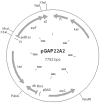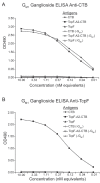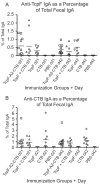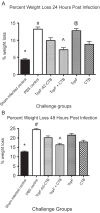Evaluation of TcpF-A2-CTB chimera and evidence of additive protective efficacy of immunizing with TcpF and CTB in the suckling mouse model of cholera
- PMID: 22879984
- PMCID: PMC3413659
- DOI: 10.1371/journal.pone.0042434
Evaluation of TcpF-A2-CTB chimera and evidence of additive protective efficacy of immunizing with TcpF and CTB in the suckling mouse model of cholera
Abstract
The secreted colonization factor, TcpF, which is produced by Vibrio cholerae 01 and 0139, has generated interest as a potential protective antigen in the development of a subunit vaccine against cholera. This study evaluated immunogenicity/protective efficacy of a TcpF holotoxin-like chimera (TcpF-A2-CTB) following intraperitoneal immunization compared to TcpF alone, a TcpF+CTB mixture, or CTB alone. Immunization with the TcpF-A2-CTB chimera elicited significantly greater amounts of anti-TcpF IgG than immunization with the other antigens (P<0.05). Protective efficacy was measured using 6-day-old pups reared from immunized dams and orogastrically challenged with a lethal dose of El Tor V. cholerae 01 Inaba strain N16961. Protection from death, and weight loss analysis at 24 and 48 hours post-infection demonstrated that immunization with TcpF alone was poorly protective. However, immunization with TcpF+CTB was highly protective and showed a trend toward greater protection than immunization with CTB alone (82% vs 64% survival). Immunization with the TcpF-A2-CTB chimera demonstrated less protection (50% survival) than immunization with the TcpF+CTB mixture. The TcpF-A2-CTB chimera used for this study contained the heterologous classical CTB variant whereas the El Tor CTB variant (expressed by the challenge strain) was used in the other immunization groups. For all immunization groups that received CTB, quantitative ELISA data demonstrated that the amounts of serum IgG directed against the homologous immunizing CTB antigen was statistically greater than the amount to the heterologous CTB antigen (P≤0.003). This finding provides a likely explanation for the poorer protection observed following immunization with the TcpF-A2-CTB chimera and the relatively high level of protection seen after immunization with homologous CTB alone. Though immunization with TcpF alone provided no protection, the additive protective effect when TcpF was combined with CTB demonstrates its possible value as a component of a multivalent subunit vaccine against Vibrio cholerae 01 and 0139.
Conflict of interest statement
Figures







Similar articles
-
Immunizing adult female mice with a TcpA-A2-CTB chimera provides a high level of protection for their pups in the infant mouse model of cholera.PLoS Negl Trop Dis. 2014 Dec 4;8(12):e3356. doi: 10.1371/journal.pntd.0003356. eCollection 2014 Dec. PLoS Negl Trop Dis. 2014. PMID: 25474636 Free PMC article.
-
Immunization with cholera toxin B subunit induces high-level protection in the suckling mouse model of cholera.PLoS One. 2013;8(2):e57269. doi: 10.1371/journal.pone.0057269. Epub 2013 Feb 28. PLoS One. 2013. PMID: 23468950 Free PMC article.
-
TcpF is a soluble colonization factor and protective antigen secreted by El Tor and classical O1 and O139 Vibrio cholerae serogroups.Infect Immun. 2005 Aug;73(8):4461-70. doi: 10.1128/IAI.73.8.4461-4470.2005. Infect Immun. 2005. PMID: 16040956 Free PMC article.
-
Pathogenic and vaccine significance of toxin-coregulated pili of Vibrio cholerae E1 Tor.J Biotechnol. 1999 Aug 20;73(2-3):109-17. doi: 10.1016/s0168-1656(99)00114-5. J Biotechnol. 1999. PMID: 10486921 Review.
-
[Cholera immunology and the molecular biology of cholera toxin. Recent progress and future prospects].Rev Alerg. 1993 Jul-Aug;40(4):91-4. Rev Alerg. 1993. PMID: 8143024 Review. Spanish.
Cited by
-
Evaluation of the Immunogenicity and Protective Efficacy of an Enterotoxigenic Escherichia coli CFA/I Adhesin-Heat-Labile Toxin Chimera.Infect Immun. 2020 Oct 19;88(11):e00252-20. doi: 10.1128/IAI.00252-20. Print 2020 Oct 19. Infect Immun. 2020. PMID: 32839188 Free PMC article.
-
Immunizing adult female mice with a TcpA-A2-CTB chimera provides a high level of protection for their pups in the infant mouse model of cholera.PLoS Negl Trop Dis. 2014 Dec 4;8(12):e3356. doi: 10.1371/journal.pntd.0003356. eCollection 2014 Dec. PLoS Negl Trop Dis. 2014. PMID: 25474636 Free PMC article.
-
Biochemical and immunological characterization of an ETEC CFA/I adhesin cholera toxin B subunit chimera.PLoS One. 2020 Mar 16;15(3):e0230138. doi: 10.1371/journal.pone.0230138. eCollection 2020. PLoS One. 2020. PMID: 32176708 Free PMC article.
-
Immunization with cholera toxin B subunit induces high-level protection in the suckling mouse model of cholera.PLoS One. 2013;8(2):e57269. doi: 10.1371/journal.pone.0057269. Epub 2013 Feb 28. PLoS One. 2013. PMID: 23468950 Free PMC article.
-
Immunization with the recombinant Cholera toxin B fused to Fimbria 2 protein protects against Bordetella pertussis infection.Biomed Res Int. 2014;2014:421486. doi: 10.1155/2014/421486. Epub 2014 May 13. Biomed Res Int. 2014. PMID: 24982881 Free PMC article.
References
-
- Sack DA, Sack RB, Nair GB, Siddique AK (2004) Cholera. Lancet 363: 223–233. - PubMed
-
- WHO/UNICEF (2010) Status and progress towards the MDG target. In:Progress on sanitation and drinking water: 2010 update.: WHO Press. 6–13 p.
-
- Plotkin SA, Orenstein WA, Offit PA (2008) Vaccines. Philadelphia: Saunders/Elsevier. xvii, 1725 p.
-
- Zhang RG, Scott DL, Westbrook ML, Nance S, Spangler BD, et al. (1995) The three-dimensional crystal structure of cholera toxin. J Mol Biol 251: 563–573. - PubMed
Publication types
MeSH terms
Substances
Grants and funding
LinkOut - more resources
Full Text Sources
Other Literature Sources
Medical

